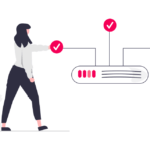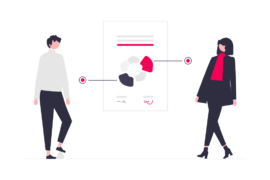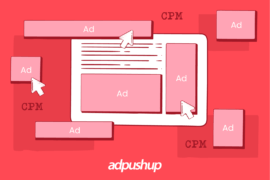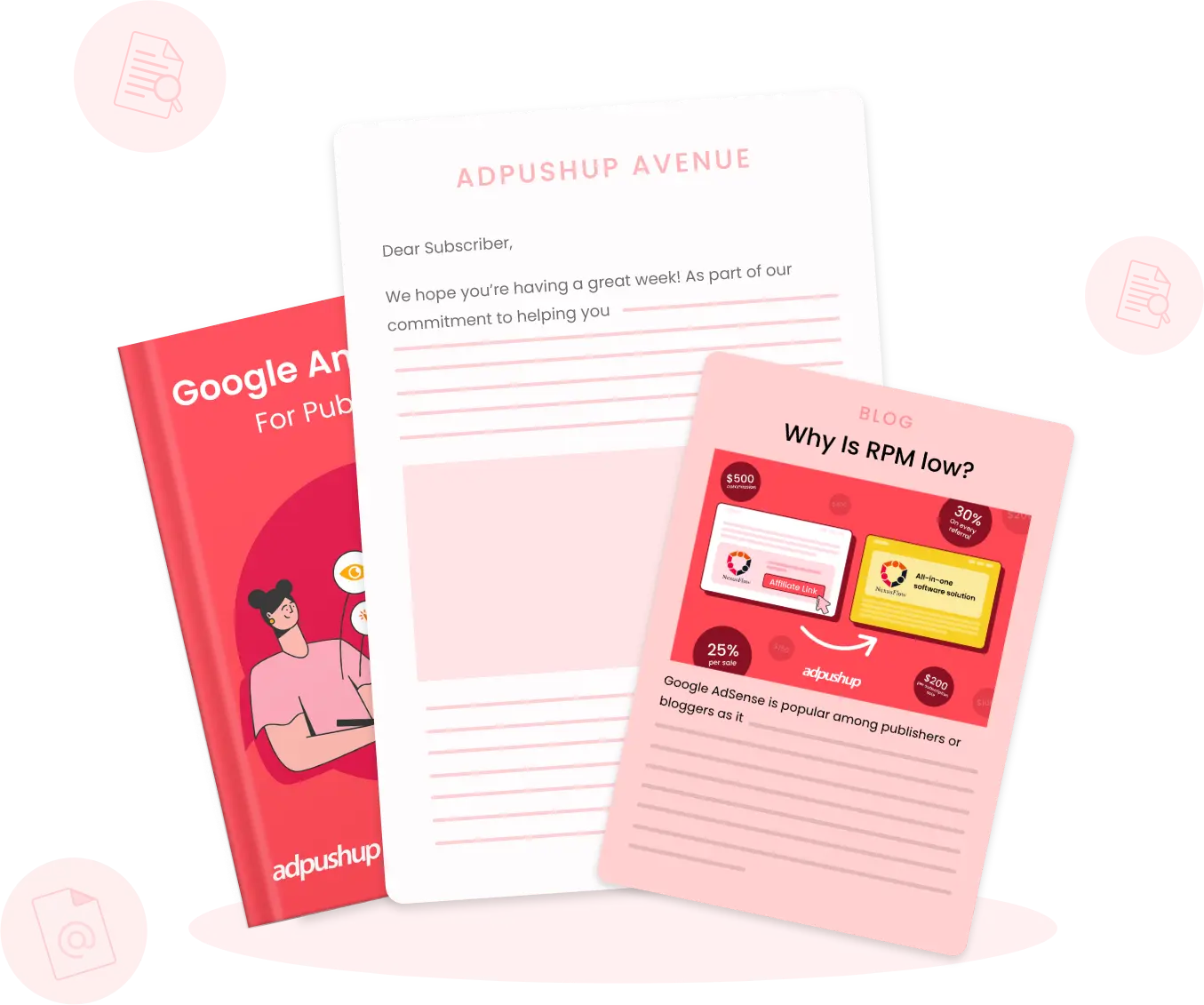Is your ad revenue stagnant or on the decline? You’re putting out quality content, but your ad revenue just isn’t reflecting its worth. The culprit might be a misunderstood metric: eCPM.
Our new blog post breaks down eCPM for publishers like you. Learn how to calculate it, optimize it, and finally MAXIMIZE your ad revenue!
If you are familiar with CPM (cost per mile), you may have also heard of eCPM and wondered about the difference. What is eCPM?
Here’s the eCPM meaning in simpler terms: eCPM is a metric that is crucial for understanding the performance of advertising campaigns and identifying opportunities to increase revenue.
Whether you’re a digital marketer, advertiser, or publisher, understanding eCPM is essential to making informed decisions and maximizing your return on investment.
Without further ado, let’s get started with understanding, calculating, and increasing your eCPM.
What is eCPM?
Before diving into Effective CPM (eCPM), let’s review the basics of CPM.
What is CPM?
CPM, or Cost Per Thousand Impressions, is the amount advertisers are willing to pay for every one thousand impressions they receive. It’s an advertisers’ side metric that helps them decide the budget of their campaigns.
CPM is calculated using this formula:

For example, if an advertiser has a budget of $100 and wants to reach 100,000 users, then his/her CPM would be $1 CPM, i.e. ($100/100,000)*1000.
Let’s now take a look at what is eCPM.
What’s eCPM (eCPM Meaning)
eCPM stands for effective cost per mile. It is the revenue earned by a publisher for every one thousand impressions. You need to pay special attention to the term ‘effective’. Here, effective CPM means the revenue earned by the publishers effectively.
It is a cumulative revenue generated by publishers per thousand impressions, some of which also get clicked and converted into leads and customers for the advertisers. Hence, eCPM is not just calculated using CPM campaigns, but also CPC, CPL, and other such campaigns running via the publisher’s inventory.
It is predicted by the ad network of the publisher using this eCPM formula:
How to Calculate eCPM? [eCPM formula]

We hope by now you have a clear understanding of what eCPM is and how is eCPM calculated. Let’s now have a look at how it differs from CPM and RPM.
Also Read – Understanding CPC vs CPM for Ad Publishers | AdPushup
Why is eCPM Important for Publishers?
eCPM helps predict the earnings of the publishers. A target earning number can work as a motivation for publishers to work accordingly. If you are performing ad testing to find the best-performing ads for your website, then eCPM achieved for different ad tests can help you choose the winner.
However, you should always keep in mind that eCPM is a prediction, and the actual earnings can vary. Also, don’t get confused between eCPM and RPM, both mean (almost) the same. Hence, whether you work on increasing RPM or eCPM, your ultimate goal remains the same, maximize ad revenue.
How Does eCPM Help in Marketing Strategies?
Integrating eCPM (effective cost per mile) into your marketing strategies can be a strategic move to optimize revenue and refine your advertising approach. Here’s how to effectively incorporate eCPM into your marketing strategies:
Performance Monitoring
Use eCPM as a key performance indicator (KPI) to monitor the effectiveness of your advertising campaigns. Regularly analyze how changes in content, ad formats, or targeting impact eCPM.
Audience Targeting and Segmentation
Leverage eCPM insights to refine your audience targeting strategies. Identify high-value audience segments that attract advertisers willing to pay a premium. Tailor your content and advertisements to cater to these lucrative segments.
Ad Placement Optimization
Experiment with different ad placements and evaluate their impact on eCPM. Ads positioned strategically for better visibility and engagement often yield higher eCPMs. Consider the fold, within content, or interactive placements for optimal results.
A/B Testing
Conduct A/B tests to compare different ad creatives, formats, or calls to action. Assess which variations contribute to higher eCPMs and incorporate these findings into your ongoing marketing strategies.
Seasonal Adjustments
Recognize and adapt to seasonal fluctuations in eCPM. Certain times of the year may experience higher advertising demand, providing an opportunity to optimize strategies for increased revenue during peak periods.
Ad Format Experimentation
Explore different ad formats to identify those that resonate best with your audience and result in higher eCPMs. For example, video ads may command a higher eCPM compared to traditional display ads.
Data-Driven Decision Making
Utilize eCPM data for informed decision-making. Understand the correlation between user engagement, ad impressions, and revenue. Make adjustments to your marketing strategies based on these insights.
Negotiation and Monetization
Use eCPM data when negotiating with advertisers or ad networks. Understanding the value of your ad inventory allows for more effective negotiations and ensures you are appropriately compensated for the quality of your audience and content.
By integrating eCPM into your marketing strategies, you can enhance the efficiency and profitability of your advertising efforts. Regularly analyze and adapt your approach based on eCPM insights to stay competitive and maximize revenue in the dynamic landscape of online marketing.
CPM vs. eCPM vs. RPM
Since we have already discussed eCPM and CPM above in the blog, let’s understand what is RPM.
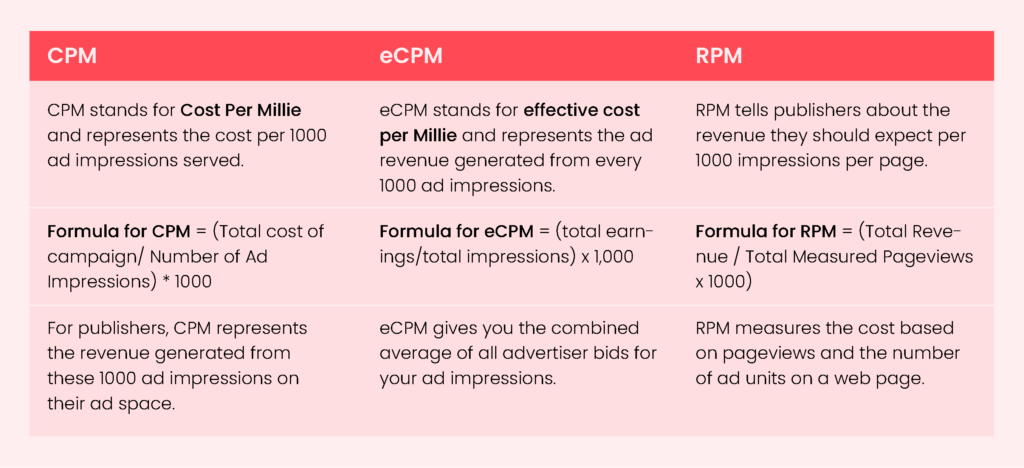
eCPM vs RPM
RPM refers to pageview-level earnings. Meaning RPM tells publishers about the revenue they should expect per thousand impressions per page. This depends on the number of page views, number of ad units, fill rate, and viewability score of these ad units, among other factors.
Google AdSense used to predict publishers’ earnings using eCPM in their previous models. However, newer AdSense versions show RPM instead of eCPM.
However, if you use Google Ad Manager, you will see eCPM in most of your reports and no mention of RPM or page RPM.
This means that eCPM and RPM refer to the same thing, according to Google. However, if you are partnered with different ad networks, it’s better to clarify with them the metrics they use to predict your earnings.
eCPM sounds a lot like RPM (revenue per thousand pageviews).
Yes, on a broad level, eCPM and RPM do sound a lot alike. This is because both are publisher-side metrics and help predict ad revenue.
eCPM vs CPM
Simply put, CPM is the money advertisers spend on a campaign. And eCPM is the estimated revenue generated per thousand impressions, and RPM is the amount earned by publishers per thousand pageviews.
What is an eCPM Floor?
An eCPM floor, in the context of programmatic advertising, refers to the minimum price set by a publisher for their ad inventory. This minimum price represents the threshold below which advertisers’ bids are not accepted. The eCPM floor is a strategic mechanism used by publishers to ensure that they receive a minimum revenue for displaying ads on their platforms.
Setting an eCPM floor allows publishers to exert control over the minimum value they are willing to accept for a thousand impressions. This floor can be influenced by various factors, including the perceived value of the ad space, the quality of the audience, and the overall goals of the publisher.
Advertisers, in turn, must bid at or above the eCPM floor to participate in the auction for that particular ad space.
The eCPM floor is a crucial tool for publishers aiming to strike a balance between maximizing revenue and maintaining the quality and relevance of the ads displayed on their platform. It provides a level of control and helps ensure that the publisher’s ad inventory is not undervalued in the programmatic advertising ecosystem.
How does eCPM Result in Income?
To understand how eCPM results in income, here are three terms you need to know:
Impressions: An impression is counted each time an ad is displayed on a webpage or in an app.
Total Earnings: This represents the total revenue generated from those impressions. Advertisers pay publishers for the ad space based on various models such as Cost Per Mille (CPM), Cost Per Click (CPC), or Cost Per Acquisition (CPA).
eCPM Calculation: By using the eCPM formula mentioned above, you get a value that represents the estimated earnings for every thousand impressions.
Income Calculation: If you have the eCPM value, you can estimate your income by multiplying the eCPM by the number of impressions and dividing by 1000.
Therefore, income = (eCPM × Total Impressions)/1000
What is a Good eCPM?
The definition of a “good” eCPM can vary depending on various factors, including the type of content, the industry, the geographic location of the audience, and the advertising platform. What may be considered a good eCPM in one context might be different in another. However, here are some general guidelines:
- Industry Standards: Different industries have different average eCPM rates. For instance, the eCPM for ads in the finance or technology sector might be higher compared to entertainment or news websites. Researching industry benchmarks can give you a better idea.
- Geographic Location: Ad rates can vary significantly based on the geographic location of your audience. Advertisers may be willing to pay more for audiences in certain regions or countries.
- Content Type: The type of content on your platform can also impact eCPM. Niches with higher-value audiences or specialized content may attract advertisers willing to pay higher rates.
- Ad Format: Different ad formats (display, video, native, etc.) have different average eCPM rates. Video ads tend to have higher eCPMs compared to display ads, for example.
- Seasonal Variations: Ad rates can fluctuate throughout the year, with higher rates during peak seasons or holidays.
- User Engagement: Platforms with highly engaged users might command higher eCPMs because advertisers value engaged and responsive audiences.
What is the Average eCPM?
While a definitive “good” eCPM is subjective, here are some general ranges:
- $2 – $10: A typical range for many publishers monetizing with display ads.
- Below $1: This might be acceptable for new websites or those in less competitive niches.
- Above $20: Excellent for most publishers, indicating highly valuable ad space.
Instead of fixating on a singular average, a more insightful approach involves comparing your eCPM to similar sites/apps within your industry.
Tracking your own eCPM trends over time provides a gauge for improvement or decline. Utilizing industry reports and benchmarks contributes to a broader understanding of average eCPMs in your specific context.
Ultimately, the paramount focus should be on optimizing your own eCPM through measures such as enhancing content, attracting a relevant audience, and experimenting with diverse ad formats and ad placements.
Why Do I Have a Low eCPM?
In case you’re wondering why you have a low eCPM, one of the major reasons behind this would be the lack of competition.
Insufficient user engagement due to low-quality content, irrelevant traffic, or poor ad placement can deter advertisers from bidding higher.
Additionally, limited ad inventory, seasonal variations in ad demand, and geographic targeting can contribute to decreased competition and lower eCPMs.
To address this, it’s crucial to optimize ad placement for visibility, target the right audience, and regularly experiment with different ad formats.
Analyzing performance data, encouraging users to disable ad blockers, and ensuring compatibility across devices and browsers are also key steps in improving eCPM. By addressing these elements, publishers can work towards enhancing their overall advertising revenue.
How to Increase eCPM? Top 12 Tips
eCPM can be tricky to work around, as there is no guarantee that you will earn the amount predicted by your eCPM calculation. However, as a publisher, you can certainly work on increasing the performance of your inventory. Here are factors that affect your earnings and help you get the highest eCPM.
1. Increase Monthly Traffic
The correlation between your monthly traffic and earnings is straightforward, making it a pivotal consideration for ad networks and advertisers when seeking publishers. Consequently, prioritizing the augmentation of your website traffic becomes a fundamental strategy to boost earnings.
To achieve this, you have the flexibility to choose between organic, paid, or a combination of both traffic acquisition methods, aligning with your budgetary constraints.
By focusing on expanding your website’s reach, you set the foundation for maximizing your earnings potential in collaboration with ad networks and advertisers.
2. Partner with Multiple Ad Networks
Ad networks help you generate demand for your inventory. Partner with multiple ad networks for better demand and value for your inventory. Do your research to find ad networks offering better deals for different geographical locations.
Adding multiple networks can get your inventory to high-paying advertisers. Also, it can increase the competition on your inventory and hence your earnings.
Looking for more demand on your inventory, we can help with our partnerships with 20+ global demand partners. Learn more.
3. Work on Your Viewability Score
Your ads are no good if users are not seeing them. Ad viewability has become an important factor for advertisers now to purchase inventory. This is why we advise publishers to work on their viewability score and combat banner blindness.
You can start by learning about viewability guidelines set by IAB, MRC, and Google. Simultaneously, you can start learning about viewable CPM (vCPM) – cost per thousand viewable impressions, where advertisers pay according to the impressions that are viewed, not the creatives that are rendered on the publisher’s site.
4. Try Active View Ad Refresh
Ad refresh can help publishers increase eCPM per session. Basically, the ad units refresh themselves after certain triggers, such as user action (click, hover) and time (after 60 seconds).
In theory, this allows publishers to inflate their inventory size. However, there are certain best practices that should be considered while implementing ad refresh to improve eCPM. For example, try active view ad refresh, this will only refresh the ad when the user is active on the screen with the ad unit – putting the advertiser’s dollar to good use and at the same time, helping publishers with their revenue.
5. Use Different Ad Formats
When it comes to ad format, go with what your users like. For that, you need to ace your testing game. Publishers have multiple ad formats available to run tests and find the best ones.
Here are some commonly-used ad formats:
1. Banner Ads
These are simple images with text in rectangle or square shapes (like 250×250, 720×90, 300×250, and more). Because of their simplicity and effective results, banner ads are the go-to solution for many publishers and advertisers.
2. Rich Media Ads
These are heavy, graphic, and media-rich ads that are interactive and appealing to users. These creatives are generally preferred for reducing banner blindness. However, rich media ads are heavy in file size as they are in gif or video formats.
3. Video Ads
Video ads get the users’ attention in the first few seconds and can result in better engagement compared to other formats. Hence, video ads are worth trying. Especially for video publishers, video ads are a must-try format.
4. Native Ads
These ads blend with the content of the webpage without disrupting the user experience. Native ads look like the organic content of the page and are proven to be beneficial for publishers with engaged, content-consuming users.
It is advisable to experiment with the combination of these ad formats to see better results.
Moreover, you can also read Google’s guidelines for appropriately placing ads on your web pages.
6. Work on User Experience
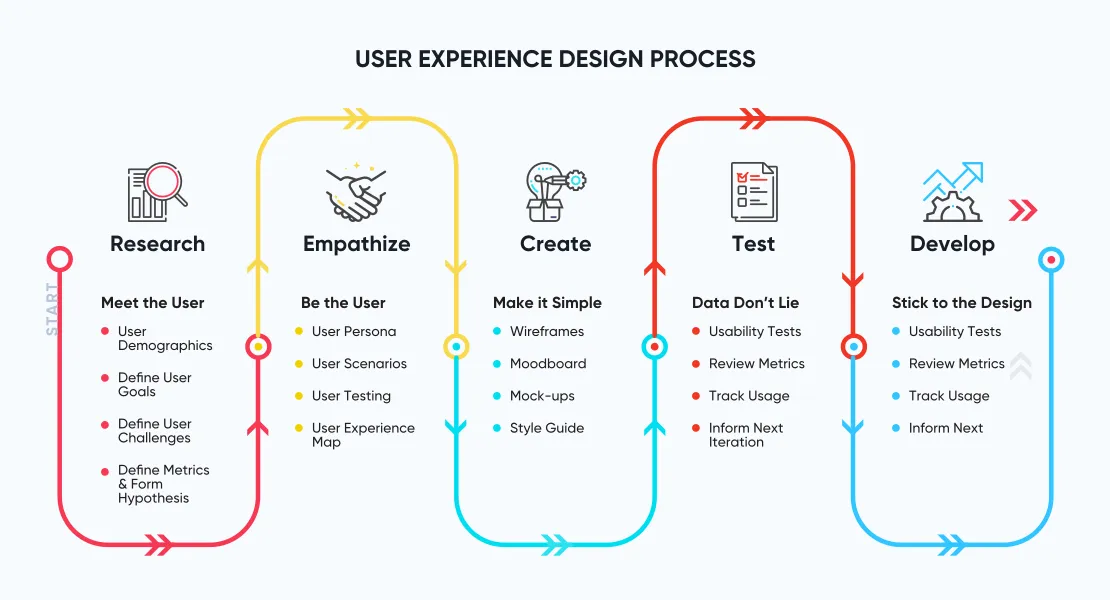
The user experience of your website can be a decisive factor in the success or failure of your efforts to boost eCPM.
A user who lands on your webpage but gets overwhelmed with ads is going to leave. This is a sign of a bad user experience. Such practices lead to the use of ad blockers amongst users, further reducing your eCPM. In fact, most ad networks, including AdSense, block publishers’ accounts for poor user experience.
Since the performance or page loading speed of your efforts will be slow, as a result, users will not be able to engage with your website.
Make sure the performance of your website is fast enough to cater to the users’ needs in a timely fashion. It’s because it will help you increase ad impressions and clicks, leading to a higher eCPM.
7. Get Search Engine Traffic
With good SEO practices, you get users to land on your website. Most of these are high-intent users and can provide quality impressions. Quality impressions benefit advertisers with their campaigns, and publishers by increasing their eCPM.
8. Make Your Website Mobile-Friendly
Mobile users have surpassed the total desktop users. Hence, this is the right time to start driving traffic from mobile users as well. For that, you need to work on making your site mobile-friendly; starting with AMP or PWA can be good options. Next, you can try mobile ad formats and sizes to make the most out of mobile ads.
9. Know The Value of Your Niche
The ad industry has seen advertisers pay more for a niche audience. Some niches are more valuable than others. Check whether you fall under the category of expensive keywords. If yes, you are in luck and can make a good ad revenue out of the market.
10. Determine the Source of Your Traffic
The content and niche of your site can be exactly the same as another site. However, there can be a huge difference in the eCPM. How?
Because of the source of the traffic. The geographical location of the audience plays a huge role in your earnings. For example, the traffic from the US is more valuable than the Philippines. If you own a site concerning a specific geographical location, it is recommended that you find a good ad network in your locality.
However, in the case of a global site, try to get premium traffic to see an increase in ad revenue. For that, you can run paid campaigns to drive the audience from a specific location or simply design your content in accordance with the targeted area.
11. Placement of Ad & Its Type
Advertisements that are placed in the most prominent space of the website, which is usually the above fold of the site, generate higher revenue. Not only that, but these ads also receive the highest number of impressions. So, place your ads ideally on web pages without hindering the content.
It’s equally important to place the right kind of ads. For example, using high-performing ad formats such as video or interstitial ads can increase your effective CPM. Once you have decided on the placement of ads and their type, keep optimizing from time to time as per requirements.
For a global site, aim for premium traffic to boost ad revenue. Use paid campaigns to target specific locations or tailor your content to suit the targeted area.
12. Seasonality Trends
Another factor that can affect your eCPM score is the changing seasons. In certain seasons, where there will be more online activities, you will see a rise in ad impressions and revenue.
For example, during the time of Christmas, when most people hop onto shopping websites, eCommerce websites will receive more traffic, and this will lead to higher eCPM.
On the other hand, in the summer season, travel websites may see an increase in traffic as more and more people are inclined towards going on vacation.
If you’ve tried the aforementioned method and still experiencing low eCPM, the following reasons may be to blame.
How does eCPM Help in Revenue Analysis and Optimisation?
Effectively utilizing eCPM (effective cost per mile) is paramount for revenue analysis and optimization in the realm of online advertising. eCPM serves as a crucial indicator, representing the estimated earnings for every thousand impressions. To enhance revenue, delve into the factors influencing eCPM and evaluate the effectiveness of your audience targeting strategies, ensuring they align with advertiser preferences and interests. Additionally, scrutinize the placement of ads on your platform – adjusting positions for optimal visibility and engagement can significantly impact eCPM. Consistently monitoring and analyzing these factors empower you to make data-driven decisions to optimize eCPM effectively.
Experimentation is a key element in eCPM optimization. Test various ad formats to identify what resonates best with your audience and yields higher eCPMs. Dynamic and engaging content can contribute to improved user engagement, positively influencing eCPM. Regularly assess the performance of your ad inventory and make informed adjustments to optimize eCPM over time. By staying attuned to industry trends and embracing a proactive approach to experimentation, you can refine your advertising strategy, driving increased revenue through enhanced eCPM performance.
Final Words On: What is eCPM?
We learned what is eCPM, how it’s calculated, and how to increase it for publishers. It’s not that difficult to understand. Is it? It’s like any other factor for publishers uses to increase their ad revenue, a lot like RPM.
The strategies mentioned above can give you a great start.
Work on increasing traffic, quality content, and user engagement. And see the upward graph for your effective CPM.
We at AdPushup, put our focus on page RPM while helping publishers with their revenue goals. This is because we consider every page has unique value when it comes to securing ad dollars. And we achieve this through our machine-learning algorithm and in-house ad operations expertise. Feel free to reach out and ask our experts.

FAQs
eCPM stands for effective cost per thousand impressions or effective cost per mille. This is a publisher-side metric to measure/predict ad revenue.
Formula to calculate eCPM = (Estimated earnings/total impressions)*1000
CPM is an advertiser-side metric that tells how much an advertiser is willing to pay. eCPM is a publisher-side metric that tells how much a publisher is expected to earn.
To increase your effective CPM, we recommend improving the viewability score, trying active view ad refresh, increasing the number of demand partners, improve user experience and traffic. For more details, read this blog post.
It depends on the type of publisher you are and the traffic you get on your site. For instance, finance niche publishers are expected to get better eCPM than software niche publishers. Similarly, if you get traffic from tier-1 countries like the US and UK, advertisers should pay good bucks for your traffic. In the end, thorough research is required to measure the good eCPM for your inventory.

Deepak has a keen eye for detail and a deep understanding of the ad tech landscape. Whether it’s through in-depth articles, thought-provoking insights, or compelling storytelling, he’s dedicated to helping people navigate the complex world of ad tech with the simplicity of his words.

